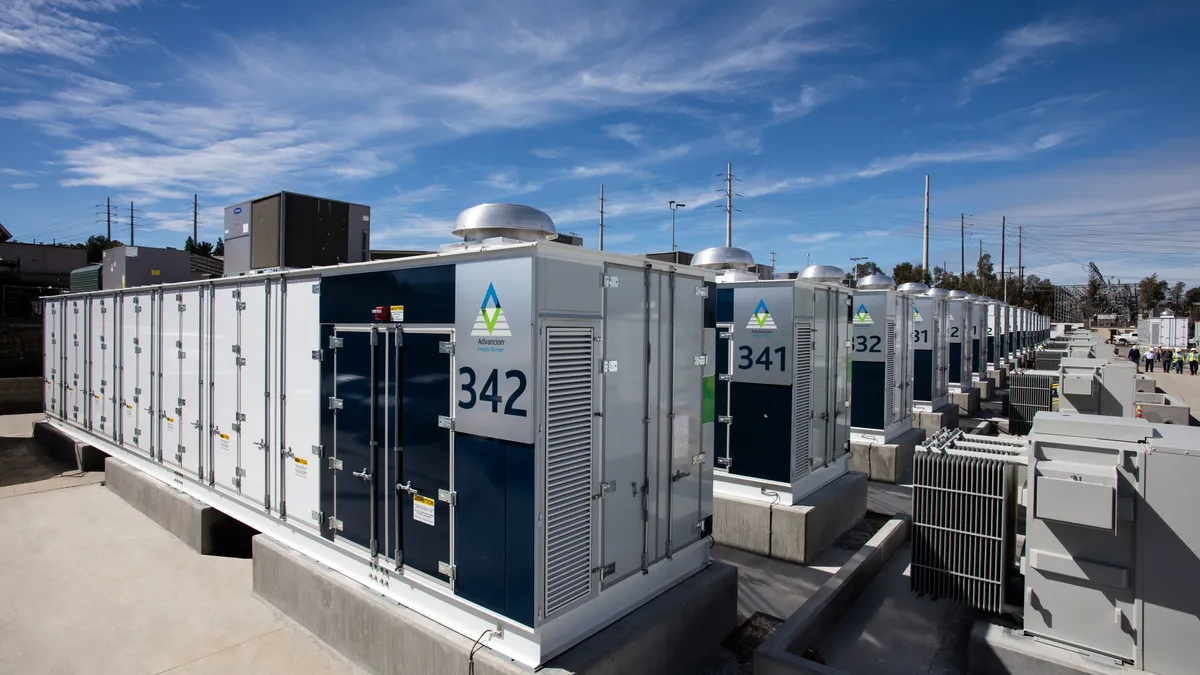UPDATE: Jan 16, 2020: The California Public Utilities Commission on Thursday approved $830 million in new funding for the Self-Generation Incentive Program, bringing the program’s total budget to $1.2 billion over the next five years. The decision “shifts the focus of SGIP towards promoting resiliency,” Commissioner Clifford Rechtschaffen said at the agency meeting.
Dive Brief:
-
California regulators are proposing to authorize an annual collection of $166 million from ratepayers from 2020 through 2024 to fund the state’s Self-Generation Incentive Program (SGIP) — and 85% of that budget will be allocated to energy storage technologies, in a bid to help communities that experience frequent public safety power shut-offs.
-
The California Public Utilities Commission's (CPUC) proposed decision would also expand the parameters of SGIP to benefit customers in high fire-threat areas. This comes after Pacific Gas & Electric (PG&E) predicted it could need to continue de-energizing certain areas for the next decade to prevent fires.
- The proposal is “very promising,” California Energy Storage Alliance (CESA) Executive Director Alex Morris told Utility Dive. The earliest the commission can approve the decision is at its Jan. 16 meeting.
Dive Insight:
The SGIP’s funds are used to incentivize customer-side distributed energy resources in California, and cover technologies like wind turbines, fuel cells and storage systems. Over the last year, as PG&E has deployed more frequent proactive shut-offs to prevent wildfires in its service territory, regulators have been exploring the potential of using the program to support customers in high fire-threat areas.
The CPUC’s proposed decision on Wednesday would allocate 15% of the program’s funds to renewable generation technologies and 85% to storage. Of this, 63% would feed into the equity resiliency budget — an allocation created by the commission in September for households in portions of the state that face the highest risk of wildfire, as well as critical facilities and infrastructure.
This allocation “will help establish developer networks that can continue to serve such communities when the SGIP program sunsets,” according to the CPUC.
CESA has been looking forward to this decision for some time, according to Morris.
“The tenor of the discussions in California changed with the October [shut-offs],” he said, adding that the proposal would help accelerate storage deployments and provide solutions for affected customers.
The commission is also considering expanding the eligibility requirements for the equity resilience budget to include customers who have experienced two or more shut-offs and could use the incentives to help install on-site battery systems before the next wildfire season. Additionally, “critical facilities” — such as grocery stores and markets, independent living centers, food banks and households that pump their water supply electrically — can participate in the program.
The program’s proposed storage allocation includes a 12% set-aside for large-scale storage systems — a significant reduction from the previous 52%. The CPUC noted in its proposed decision that large-scale storage projects have access to around $368 million in incentives until 2025 due to previously unspent funds, which is “sufficient to encourage developer investment.”
The CPUC’s proposal comes despite concerns from ratepayer advocates about the SGIP’s inconsistent record with reducing greenhouse gas (GHG) emissions. Evaluations of the program dating back to 2014-2015 have found that its storage technologies have actually been increasing emissions since the batteries charged during periods when more fossil fuel-based energy was on the grid.
In 2016, commercial storage projects launched under the program increased net emissions by 726 metric tons of carbon dioxide, the CPUC found. And in 2017, SGIP commercial and residential storage projects increased emissions by 1,436 and 116 metric tons, respectively.
“This is in direct contradiction to the intent of the SGIP statute,” the California Public Advocates’ Office said in comments filed with the CPUC on May 30.
Morris said that storage operators in California have learned a lot about how to operate and signal behind-the-meter systems in a way that reduces greenhouse gas emissions. In August, the commission attempted to address this problem by approving new rules for the program, requiring SGIP program administrators to provide a digital GHG signal to help storage systems reduce emissions.
“We expect better alignment between grid conditions, and retail rates will also drive GHG emission reductions from storage,” Morris said.
The California Public Advocates’ Office did not respond to a request for comment.















